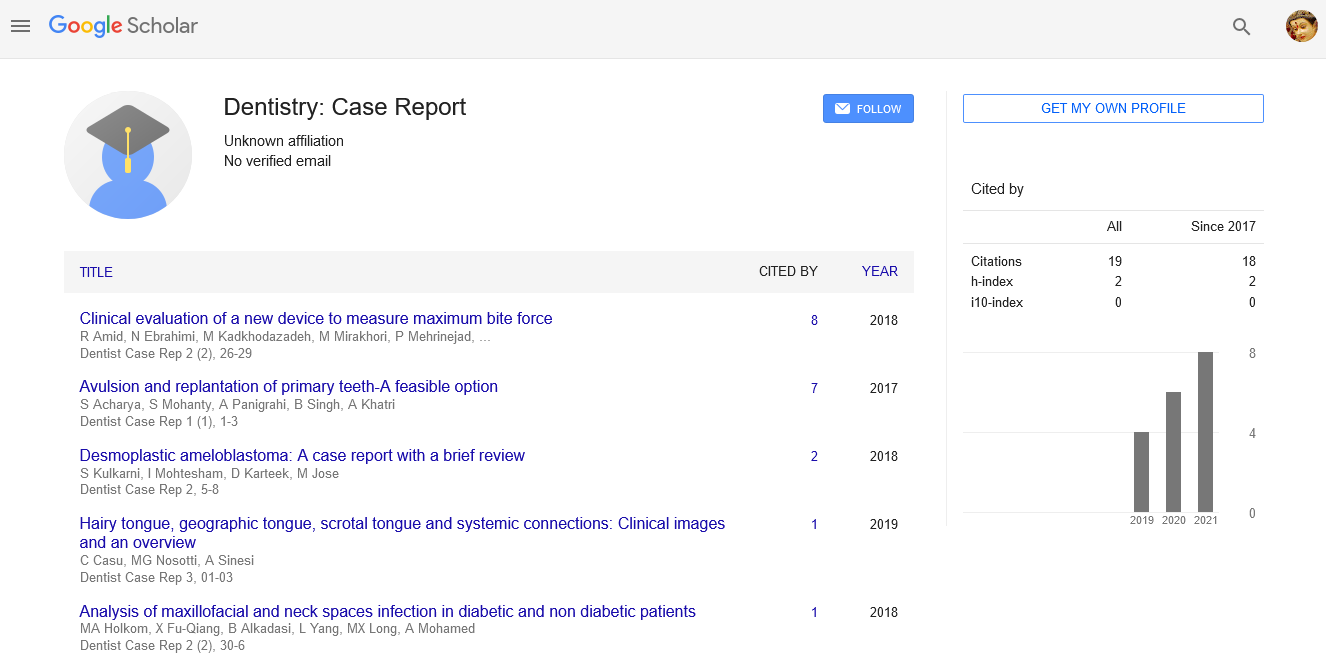Root canal treatment and tooth autotransplantation
Received: 03-May-2022, Manuscript No. puldcr-22-5108; Editor assigned: 06-May-2022, Pre QC No. puldcr-22-5108(PQ); Reviewed: 23-May-2022 QC No. puldcr-22-5108(Q); Revised: 26-May-2022, Manuscript No. puldcr-22-5108(R); Published: 30-May-2022, DOI: 10.37532. puldcr-22.6.3.9-10
This open-access article is distributed under the terms of the Creative Commons Attribution Non-Commercial License (CC BY-NC) (http://creativecommons.org/licenses/by-nc/4.0/), which permits reuse, distribution and reproduction of the article, provided that the original work is properly cited and the reuse is restricted to noncommercial purposes. For commercial reuse, contact reprints@pulsus.com
Abstract
The term "root canal treatment" describes a procedure in which the diseased and damaged dental pulp is extracted and replaced with a sterile and biocompatible material. This procedure also involves the healing of the infection's focal point while enhancing the tooth's overall function and appearance. Modern endodontics' fundamental tenet is that treatment should be painless and successful. A properly done patient interview is helpful in determining the best therapeutic co-course of action, particularly with relation to endodontics, which frequently eliminates tooth loss. Although endodontic pain still elicits the strongest feelings, it is generally moderate and never intense. Clinicians are morally required to provide patients with information on all viable treatment alternatives, including benefits and risks, and to get informed consent before starting therapy.
Key Words
Primary root canal; Human pulp; Tooth root
Introduction
The objectives of endodontic treatments include preventing or Ttreating apical periodontitis of endodontic origin, guaranteeing the stability of outcomes over time to prevent the illness from returning, and avoiding the need for tooth extraction.
The area of dentistry known as endodontics treats illnesses of the human pulp, tooth root, and surrounding tissue. Since it is a profession founded on the coordination of other disciplines, a number of criteria should be taken into account while making clinical decisions. The core of routine clinical practice is the process of clinical decision-making.
Primary Root Canal Treatment
To assess the variables determining the success of primary root canal treatments, various systematic reviews have been conducted [1]. In general, the following factors are substantially linked to the immediate or delayed failure of endodontic therapies: insufficient mechanical instrumentation, insufficient chemical cleaning of canals, and poor quality root canal filling and post-treatment repair [2]. The endodontic infection's bacterial cause is not resolved as a result of any of these issues. In actuality, their persistence and secondary contamination of the root canal system, which could result in recurrent disease with the worsening of symptoms, are the most major causes of primary Root Canal Treatment (RCT) failure.
The mechanical breakage of teeth during endodontic treatment is a possible cause of long-term failure, thus recurring infections are not the only factor [3,4]. As convincingly shown, post-endodontic restoration of teeth with crowns or cast restorations does not affect the success of the treatment based on periapical healing as long as there is no indication of coronal leakage; however, it can affect the survival rate of teeth over time, lowering the rate of mechanical failure [5]. Despite this, the results of the research remain ambiguous with regard to the connection between the long-term RCT outcome and the post-endodontic treatment plan in terms of the preferred material [6].
Tooth Autotransplantation
A well-known surgical procedure for replacing missing or irreparable teeth is tooth autotransplantation. The type of transplanted tooth, donor tooth development stage, surgical technique, follow-up time, and study methodology all affect the survival and success rates of transplanted teeth [5]. It is widely recognised that the periodontal ligament cells' ability to survive after the donor tooth has been extracted is the key to a successful tooth transplant [7,8]. Rarely are revascularization and reinnervation of the transplanted tooth with fully formed roots anticipated [6]. The success rate of tooth autotransplantation following root canal filling (RCF) was higher for entire root teeth than for teeth without RCF. To prevent apical inflammation caused by pulp necrosis, endodontic treatments will therefore be necessary either before or after the surgery [9,10]. Premolar autotransplantation has established itself as a trustworthy orthodontic treatment method [8]. It's interesting to note that a difficult approach for successfully closing the oriental communication after molar extraction was the transplantation of a mature third molar.
REFERENCES
- Arias A, Peters OA. Present status and future directions: Canal shaping. Int Endod J. 2022. [Google Scholar] [CrossRef]
- Burns LE, Kim J, Wu Y, et al. Outcomes of primary root canal therapy: An updated systematic review of longitudinal clinical studies published between 2003 and 2020. Int Endod J. 2022. [Google Scholar] [CrossRef]
- Ng YL, Mann V, Rahbaran S, et al. Outcome of primary root canal treatment: systematic review of the literature–part 1. Effects of study characteristics on probability of success. Int Endod J. 2007;40(12):921-39. [Google Scholar] [CrossRef]
- Ng YL, Mann V, Rahbaran S, et al. Outcome of primary root canal treatment: systematic review of the literature–Part 2. Influence of clinical factors. Int Endod J. 2008;41(1):6-31. [Google Scholar] [CrossRef]
- Fathi A, Ebadian B, Dezaki SN, et al. An Umbrella Review of Systematic Reviews and Meta-Analyses Evaluating the Success Rate of Prosthetic Restorations on Endodontically Treated Teeth. Int Endod J. [Google Scholar] [CrossRef]
- Tsukiboshi M. Autogenous tooth transplantation: a reevaluation. Int J Periodontics Restor Dent. 1993;13(2). [Google Scholar] [CrossRef]
- Tsukiboshi M. Autotransplantation of teeth: requirements for predictable success. Dent Traumatol. 2002;18(4):157-80. [Google Scholar] [CrossRef]
- Kallu R, Vinckier F, Politis C, et al. Tooth transplantations: a descriptive retrospective study. Int J Oral Maxillofac Surg. 2005;34(7):745-55. [Google Scholar] [CrossRef]
- Andreasen JO, Paulsen HU, Yu Z, et al. A long-term study of 370 autotransplanted premolars. Part III. Periodontal healing subsequent to transplantation. Eur J Orthod. 1990;12(1):25-37. [Google Scholar] [CrossRef]
- Andreasen JO, Paulsen HU, Yu Z, et al. A long-term study of 370 autotransplanted premolars. Part IV. Root development subsequent to transplantation. Eur J Orthod 1990;12(1):38-50. [Google Scholar] [CrossRef]





